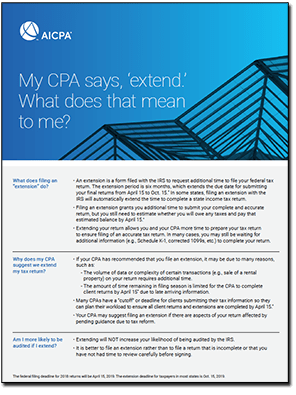There were a number of important tax developments in the first quarter of 2019, that may affect you, your family, your investments, and your livelihood, including:
- Estimated Tax Penalty Relief
- Employer Identification Number (EIN)
- Electric Car Credit Declines
- Deduction for Back Alimony
- Qualified Business Income Deduction
- Qualified Business Income Deduction: Calculating W-2 Wages
- Qualified Business Income Deduction: Rental Real Estate Safe Harbor
- Options for Those Unable to Pay the Taxman
Estimated Tax Penalty Relief
The IRS announced that it is waiving the estimated tax penalty for many taxpayers whose 2018 federal income tax withholding and estimated tax payments fell short of their total tax liability for the year. This waiver covers taxpayers whose total withholding and estimated tax payments are equal to or greater than 80 percent of their taxes owed, rather than the usual statutory percentage threshold of 90 percent. This relief expanded that initially offered by IRS; the earlier relief pertained to taxpayers who had paid 85 percent of their taxes owed. The relief was prompted by changes in the Tax Cuts and Jobs Act (TCJA; P.L. 115-97, 12/22/2017), some of the which might impact withholding (e.g., the repeal of the personal exemptions and many itemized deductions and the capping the state and local income tax deduction at $10,000). A Government Accountability Office (GAO) report estimated that nearly 30 million taxpayers could be underwithheld in 2018. IRS also provided procedures for requesting the waiver and procedures under which taxpayers who have already paid underpayment penalties but who now qualify for relief may request a refund.
For more information, view this Forbes article “IRS Expands Tax Underpayment Penalty Relief.” Then give us a call to discuss its potential impact.
Employer Identification Number (EIN)
As part of its ongoing security review, the IRS announced that, starting May 13, only individuals with tax identification numbers may request an Employer Identification Number (EIN) as the “responsible party” on the application. Individuals named as responsible party must have either a Social Security number (SSN) or an individual taxpayer identification number (ITIN). Under Code Sec. 6109(a)(1), persons are required to include taxpayer identifying numbers on returns, statements, or other documents filed with the IRS. One of the principal types of taxpayer identifying numbers is an EIN. IRS generally assigns an EIN for use by employers, sole proprietors, corporations, partnerships, nonprofit associations, trusts, estates, government agencies, certain individuals, and other business entities for tax filing and reporting purposes. A person required to furnish an EIN must apply for one with the IRS on a Form SS-4 (Application for Employer Identification Number). The new change will prohibit entities from using their own EINs to obtain additional EINs. The requirement will apply to both the paper Form SS-4 and online EIN application.
For more information, view the IRS site here; then contact us about its impact on you and your business.
Electric Car Credit Declines
IRS announced that, during the fourth quarter of 2018, General Motors (GM) reached a total of more than 200,000 sales of vehicles eligible for the plug-in electric drive motor vehicle credit under Code Sec. 30D(a). Accordingly, the credit for all new qualified plug-in electric drive motor vehicles sold by GM will begin to phase out Apr. 1, 2019. Qualifying vehicles from GM purchased for use or lease are eligible for a $7,500 credit if acquired before Apr. 1, 2019. Beginning Apr. 1, 2019, the credit will be $3,750 for GM’s eligible vehicles. Beginning Oct. 1, 2019, the credit will be reduced to $1,875. After Mar. 31, 2019, no credit will be available.
For more information, see IRS announces phase-out of credit for GM plug-in electric drive motor vehicles.
Deduction for Back Alimony
The Tax Court held that an ex-husband’s payment of alimony arrearages resulted from a contempt order by a Family Court was not a “money judgment”, and so qualified as deductible alimony. With respect to divorce instruments executed before Jan. 1, 2019, amounts received as alimony or separate maintenance payments are taxable to the recipient and deductible by the payor in the year paid. An alimony payment is one that meets the certain specific requirements, such as it must be made under a divorce or separation instrument and the payor’s obligation to make the payment must end at the death of the payee spouse. On the other hand, a money judgment is a document issued by a court stating that the creditor (or other plaintiff) has won a lawsuit and is entitled to a certain amount of money. A NY court found a taxpayer to be in contempt due to his failure to make his alimony payments and sentenced him to 150 days in jail unless he paid $225,000 to his former spouse. The taxpayer paid the $225,000 at issue and claimed an alimony deduction. The Tax Court found that the court’s order was not a money judgment, but rather a contempt order to achieve the payment of alimony arrearages which retained their character as alimony.
For more information, see the IRS’s tax treatment of alimony webpage. Then, contact us with questions about how this change may impact your taxes.
Qualified Business Income Deduction: Final Regulations
The IRS issued final Code Sec. 199A regulations for determining the amount of the deduction of up to 20% of income from a domestic business operated as a sole proprietorship or through a partnership, S corporation, trust, or estate (the qualified business income deduction). The regulations cover a wide range of topics and discuss the operational rules, including definitions, computational rules, special rules, and reporting requirements; the determination of W-2 wages and unadjusted basis immediately after acquisition of qualified property; the computation of qualified business income, qualified real estate investment trust (REIT) dividends, and qualified publicly traded partnership income; the optional aggregation of trades or businesses; the treatment of specified services trades or businesses and the trade or business of being an employee; and the rules for relevant passthrough entities, publicly traded partnerships, beneficiaries, trusts, and estates.
For more information, see IRS issues final Sec. 199A qualified business income deduction regs; Final Sec. 199A qualified business income deduction regs: Qualified business income; and Final Sec. 199A regs explain specified service trade/business and trade/business of being an employee.
Qualified Business Income Deduction: Calculating W-2 Wages
IRS provided three methods for calculating W-2 wages under Code Sec. 199A, the qualified business income deduction, for purposes of the deduction limitation based on W-2 wages and for purposes of the deduction reduction for certain specified agricultural and horticultural cooperative patrons. Under Code Sec. 199A, W-2 wages include:
- The total amount of wages as defined in Code Sec. 3401(a) (dealing with income tax withholding);
- The total amount of elective deferrals (within the meaning of Code Sec. 402(g)(3));
- Compensation deferred under Code Sec. 457; and
- The amount of designated Roth contributions.
For any taxable year, a taxpayer must calculate W-2 wages for purposes of Code Sec. 199A using one of the three methods provided by IRS. The first method (the unmodified Box method) allows for a simplified calculation, while the second and third methods (the modified Box 1 method and the tracking wages method) provide greater accuracy. The Box numbers referenced under each method refers to those on the Forms W-2 (Wage and Tax Statement).
For more information, see Rev Proc provides methods for calculating W-2 wages for Sec. 199A purposes.
Qualified Business Income Deduction: Rental Real Estate Safe Harbor
The IRS provided a safe harbor under which a rental real estate enterprise will be treated as a trade or business for purposes of the qualified business income deduction under Code Sec. 199A. That Code provision provides a deduction to non-corporate taxpayers of up to 20% of the taxpayer’s qualified business income from each of the taxpayer’s qualified trades or businesses, including those operated through a partnership, S corporation, or sole proprietorship, as well as a deduction of up to 20% of aggregate qualified real estate investment trust (REIT) dividends and qualified publicly traded partnership income. Solely for this purpose, a rental real estate enterprise will be treated as a trade or business if:
- Separate books and records are maintained to reflect income and expenses for each rental real estate enterprise;
- For tax years beginning prior to Jan. 1, 2023, 250 or more hours of rental services were performed per year with respect to the rental enterprise; and
- The taxpayer maintains contemporaneous records on the hours of all services performed; a description of all services performed; the dates on which such services were performed; and who performed the services. (This contemporaneous records requirement doesn’t apply to tax years beginning before Jan. 1, 2019).
For more information, see this Forbes article Understanding the 199A Deduction After the New IRS Final Regulations.
Options for Those Unable to Pay the Taxman
The April 15th deadline for filing 2018 income tax returns (for most taxpayers, at least; April 17 for Maine, Massachusetts and the District of Columbia) has recently passed. The IRS advised taxpayers who don’t have cash to pay the balance due on their returns, that taxpayers can avoid penalties but not interest if they can get an extension of time to pay from the IRS. However, such extensions merely postpone the day of reckoning for the period of the extension (generally, six months). The IRS outlined other ways in which financially distressed clients may be able to defer paying their income taxes, including installment agreements (a short-term 120-day payment plan and a long-term payment plan) and an offer in compromise with the IRS.
For more information, see the IRS’ information for tax payment options.











Recent Comments